


As mentioned in the preface, the fragmentation of the first gaseous objects is a well-posed physics problem with well specified initial conditions, for a given power-spectrum of primordial density fluctuations. This problem is ideally suited for three-dimensional computer simulations, since it cannot be reliably addressed in idealized 1D or 2D geometries.
Recently, two groups have attempted detailed 3D simulations of the
formation process of the first stars in a halo of ~ 106
M by
following the dynamics of both the dark matter and the gas components,
including H2 chemistry and cooling. Bromm, Coppi, &
Larson (1999)
[57]
have used a Smooth Particle Hydrodynamics (SPH) code to
simulate the collapse of a top-hat overdensity with a prescribed solid-body
rotation (corresponding to a spin parameter
by
following the dynamics of both the dark matter and the gas components,
including H2 chemistry and cooling. Bromm, Coppi, &
Larson (1999)
[57]
have used a Smooth Particle Hydrodynamics (SPH) code to
simulate the collapse of a top-hat overdensity with a prescribed solid-body
rotation (corresponding to a spin parameter
 = 5%) and additional
small perturbations with P(k)
= 5%) and additional
small perturbations with P(k)
 k-3
added to the top-hat profile. Abel et al. (2002)
[5]
isolated a high-density filament
out of a larger simulated cosmological volume and followed the evolution of
its density maximum with exceedingly high resolution using an Adaptive
Mesh Refinement (AMR) algorithm.
k-3
added to the top-hat profile. Abel et al. (2002)
[5]
isolated a high-density filament
out of a larger simulated cosmological volume and followed the evolution of
its density maximum with exceedingly high resolution using an Adaptive
Mesh Refinement (AMR) algorithm.
The generic results of Bromm et al. (1999
[57];
see also Bromm 2000
[58])
are illustrated in Figure 21. The collapsing
region forms a disk which
fragments into many clumps. The clumps have a typical mass ~
102 - 103
M . This
mass scale corresponds to the Jeans mass for a
temperature of ~ 500K and the density ~ 104
cm-3 where
the gas lingers because its cooling time is longer than its collapse time
at that point (see Fig. 22). Each clump
accretes mass slowly
until it exceeds the Jeans mass and collapses at a roughly constant
temperature (isothermally) due to H2 cooling that brings the
gas to a fixed temperature floor. The clump formation efficiency is high
in this simulation due to the synchronized collapse of the overall
top-hat perturbation.
. This
mass scale corresponds to the Jeans mass for a
temperature of ~ 500K and the density ~ 104
cm-3 where
the gas lingers because its cooling time is longer than its collapse time
at that point (see Fig. 22). Each clump
accretes mass slowly
until it exceeds the Jeans mass and collapses at a roughly constant
temperature (isothermally) due to H2 cooling that brings the
gas to a fixed temperature floor. The clump formation efficiency is high
in this simulation due to the synchronized collapse of the overall
top-hat perturbation.
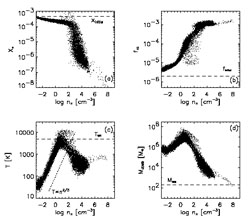 |
Figure 21. Numerical results from Bromm et
al. (1999)
[57],
showing gas properties at z = 31.2 for a collapsing slightly
inhomogeneous top-hat region with a prescribed solid-body
rotation. (a) Free electron fraction (by number) vs. hydrogen
number density (in cm-3). At
densities exceeding n ~ 103 cm-3,
recombination is very efficient, and the gas becomes almost completely
neutral. (b) Molecular hydrogen fraction vs. number
density. After a quick initial rise, the H2 fraction
approaches the asymptotic value of f ~
10-3, due to the H- channel. (c) Gas
temperature vs. number density. At densities below ~ 1
cm-3, the gas temperature rises because of adiabatic
compression until it reaches the virial value of Tvir
|
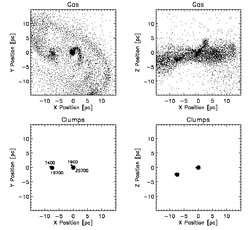 |
Figure 22. Gas and clump morphology at
z = 28.9 in the simulation of Bromm et al. (1999)
[57].
Top row: The remaining gas in the diffuse phase.
Bottom row: Distribution of clumps. The numbers next to the dots
denote clump mass in units of
M |
Bromm (2000)
[58]
has simulated the collapse of one of the above-mentioned clumps with ~ 1000
M and
demonstrated that it
does not tend to fragment into sub-components. Rather, the clump core of
~ 100M
and
demonstrated that it
does not tend to fragment into sub-components. Rather, the clump core of
~ 100M free-falls towards the center leaving an extended
envelope behind with a roughly isothermal density profile. At very high
gas densities, three-body reactions become important in the chemistry of
H2. Omukai & Nishi (1998)
[274]
have included these reactions
as well as radiative transfer and followed the collapse in spherical
symmetry up to stellar densities. Radiation pressure from nuclear burning
at the center is unlikely to reverse the infall as the stellar mass builds
up. These calculations indicate that each clump may end as a single
massive star; however, it is conceivable that angular momentum may
eventually halt the collapsing cloud and lead to the formation of a binary
stellar system instead.
free-falls towards the center leaving an extended
envelope behind with a roughly isothermal density profile. At very high
gas densities, three-body reactions become important in the chemistry of
H2. Omukai & Nishi (1998)
[274]
have included these reactions
as well as radiative transfer and followed the collapse in spherical
symmetry up to stellar densities. Radiation pressure from nuclear burning
at the center is unlikely to reverse the infall as the stellar mass builds
up. These calculations indicate that each clump may end as a single
massive star; however, it is conceivable that angular momentum may
eventually halt the collapsing cloud and lead to the formation of a binary
stellar system instead.
The Jeans mass, which is defined based on small fluctuations in a
background of uniform density, does not strictly apply in the
context of collapsing gas cores. We can instead use a slightly modified
critical mass known as the Bonnor-Ebert mass
[53,
114].
For baryons in a background of uniform density
 b,
perturbations are unstable to
gravitational collapse in a region more massive than the Jeans
mass. Instead of a uniform background, we consider a spherical,
non-singular, isothermal, self-gravitating gas in hydrostatic equilibrium,
i.e., a centrally-concentrated object which more closely resembles the gas
cores found in the above-mentioned simulations. In this case, small
fluctuations are unstable and lead to collapse if the sphere is more
massive than the Bonnor-Ebert mass MBE, given by the same
expression the Jeans Mass but with a different coefficient (1.2
instead of 2.9) and with
b,
perturbations are unstable to
gravitational collapse in a region more massive than the Jeans
mass. Instead of a uniform background, we consider a spherical,
non-singular, isothermal, self-gravitating gas in hydrostatic equilibrium,
i.e., a centrally-concentrated object which more closely resembles the gas
cores found in the above-mentioned simulations. In this case, small
fluctuations are unstable and lead to collapse if the sphere is more
massive than the Bonnor-Ebert mass MBE, given by the same
expression the Jeans Mass but with a different coefficient (1.2
instead of 2.9) and with
 b
denoting in this case the gas (volume) density at the surface of the sphere,
b
denoting in this case the gas (volume) density at the surface of the sphere,
 |
(104) |
In their simulation, Abel et al. (2000)
[4]
adopted the actual
cosmological density perturbations as initial conditions. The simulation
focused on the density peak of a filament within the IGM, and evolved it to
very high densities (Fig. 23). Following the
initial collapse of the filament, a clump core formed with ~ 200
M ,
amounting to only
~ 1% of the virialized mass. Subsequently due to slow cooling, the
clump collapsed subsonically in a state close to hydrostatic equilibrium
(see Fig. 24). Unlike the idealized top-hat
simulation of Bromm et al. (2001)
[59],
the collapse of the different clumps within
the filament is not synchronized. Once the first star forms at the center
of the first collapsing clump, it is likely to affect the formation of
other stars in its vicinity.
,
amounting to only
~ 1% of the virialized mass. Subsequently due to slow cooling, the
clump collapsed subsonically in a state close to hydrostatic equilibrium
(see Fig. 24). Unlike the idealized top-hat
simulation of Bromm et al. (2001)
[59],
the collapse of the different clumps within
the filament is not synchronized. Once the first star forms at the center
of the first collapsing clump, it is likely to affect the formation of
other stars in its vicinity.
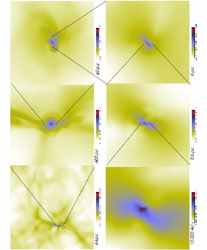 |
Figure 23. Zooming in on the core of a star forming region with the Adaptive Mesh Refinement simulation of Abel et al. (2000) [4]. The panels show different length scales, decreasing clockwise by an order of magnitude between adjacent panels. Note the large dynamic range of scales which are being resolved, from 6 kpc (top left panel) down to 10,000 AU (bottom left panel). |
As soon as nuclear burning sets in the core of the proto-star, the
radiation emitted by the star starts to affect the infall of the
surrounding gas towards it. The radiative feedback involves
photo-dissociation of H2,
Ly radiation pressure, and
photo-evaporation of the accretion disk. Tan & McKee
[357]
studied these effects by extrapolating analytically the infall of gas from
the final snapshot of the above resolution-limited simulations to the scale
of a proto-star; they concluded that nuclear burning (and hence the
feedback) starts when the proton-star accretes ~ 30
M
radiation pressure, and
photo-evaporation of the accretion disk. Tan & McKee
[357]
studied these effects by extrapolating analytically the infall of gas from
the final snapshot of the above resolution-limited simulations to the scale
of a proto-star; they concluded that nuclear burning (and hence the
feedback) starts when the proton-star accretes ~ 30
M and
accretion is likely to be terminated when the star reaches ~
200 M
and
accretion is likely to be terminated when the star reaches ~
200 M .
.
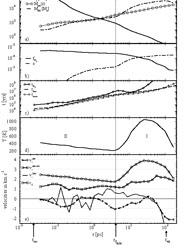 |
Figure 24. Gas profiles from the simulation
of Abel et al. (2000)
[4].
The cell size on the finest grid corresponds to 0.024
pc, while the simulation box size corresponds to 6.4 kpc. Shown are
spherically-averaged mass-weighted profiles around the baryon density peak
shortly before a well defined fragment forms (z = 19.1). Panel
(a) shows the baryonic number density, enclosed gas mass in solar mass,
and the local Bonnor-Ebert mass MBE (see text).
Panel (b) plots the molecular hydrogen fraction (by number)
fH2
and the free electron fraction x. The H2 cooling time,
tH2, the time it takes a sound wave to
travel to the center,
tcross, and the free - fall time
tff = [3 |
If the clumps in the above simulations end up forming individual very massive stars, then these stars will likely radiate copious amounts of ionizing radiation [50, 370, 59] and expel strong winds. Hence, the stars will have a large effect on their interstellar environment, and feedback is likely to control the overall star formation efficiency. This efficiency is likely to be small in galactic potential wells which have a virial temperature lower than the temperature of photoionized gas, ~ 104K. In such potential wells, the gas may go through only a single generation of star formation, leading to a "suicidal" population of massive stars.
The final state in the evolution of these stars is uncertain; but if their
mass loss is not too extensive, then they are likely to end up as black
holes
[50,
137].
The remnants may provide the seeds of quasar black holes
[215].
Some of the massive stars may end their lives by
producing gamma-ray bursts. If so then the broad-band afterglows of these
bursts could provide a powerful tool for probing the epoch of reionization
[214,
94]).
There is no better way to end the dark ages than with
 -ray burst
fireworks.
-ray burst
fireworks.
Where are the first stars or their remnants located today? The very
first stars formed in rare
high- peaks and hence
are likely to populate the cores of present-day galaxies
[380]. However, the bulk
of the stars which formed in low-mass systems at later times are expected
to behave similarly to the collisionless dark matter particles and populate
galaxy halos
[221].
peaks and hence
are likely to populate the cores of present-day galaxies
[380]. However, the bulk
of the stars which formed in low-mass systems at later times are expected
to behave similarly to the collisionless dark matter particles and populate
galaxy halos
[221].
5.2. The Mass Function of Stars
Currently, we do not have direct observational constraints on how the first stars, the so-called Population III stars, formed at the end of the cosmic dark ages. It is, therefore, instructive to briefly summarize what we have learned about star formation in the present-day Universe, where theoretical reasoning is guided by a wealth of observational data (see [293] for a recent review).
Population I stars form out of cold, dense molecular gas that is structured in a complex, highly inhomogeneous way. The molecular clouds are supported against gravity by turbulent velocity fields and pervaded on large scales by magnetic fields. Stars tend to form in clusters, ranging from a few hundred up to ~ 106 stars. It appears likely that the clustered nature of star formation leads to complicated dynamics and tidal interactions that transport angular momentum, thus allowing the collapsing gas to overcome the classical centrifugal barrier [216]. The initial mass function (IMF) of Pop I stars is observed to have the approximate Salpeter form (e.g., [208])
 |
(105) |
where
 |
(106) |
The lower cutoff in mass corresponds roughly to the opacity limit for
fragmentation. This limit reflects the minimum fragment mass, set when the
rate at which gravitational energy is released during the collapse exceeds
the rate at which the gas can cool (e.g.,
[298]).
The most important feature of the observed IMF is that ~ 1
M is the
characteristic mass scale of Pop I star formation, in the sense that most
of the mass goes into stars with masses close to this value. In
Figure 25, we show the result from a recent
hydrodynamical simulation of the collapse and fragmentation of a
molecular cloud core
[31,
32].
This simulation illustrates the highly dynamic and
chaotic nature of the star formation process
6.
is the
characteristic mass scale of Pop I star formation, in the sense that most
of the mass goes into stars with masses close to this value. In
Figure 25, we show the result from a recent
hydrodynamical simulation of the collapse and fragmentation of a
molecular cloud core
[31,
32].
This simulation illustrates the highly dynamic and
chaotic nature of the star formation process
6.
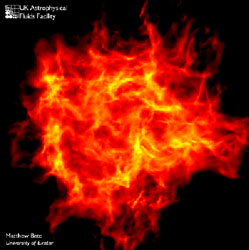 |
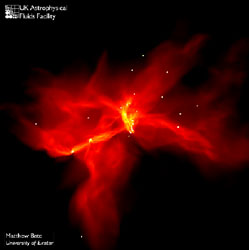 |
Figure 25. A hydrodynamic
simulation of the collapse and fragmentation
of a turbulent molecular cloud in the present-day Universe (from
[32]).
The cloud has a mass of 50
M |
|
The metal-rich chemistry, magnetohydrodynamics, and radiative
transfer involved in present-day star formation is complex, and we
still lack a comprehensive theoretical framework that predicts the IMF
from first principles. Star formation in the high redshift Universe,
on the other hand, poses a theoretically more tractable problem due to
a number of simplifying features, such as: (i) the initial absence of
heavy metals and therefore of dust; and (ii) the absence of
dynamically-significant magnetic fields, in the pristine gas left over
from the big bang. The cooling of the primordial gas does then only
depend on hydrogen in its atomic and molecular form. Whereas in the
present-day interstellar medium, the initial state of the star forming
cloud is poorly constrained, the corresponding initial conditions for
primordial star formation are simple, given by the popular
 CDM model of
cosmological structure formation. We now turn to
a discussion of this theoretically attractive and important problem.
CDM model of
cosmological structure formation. We now turn to
a discussion of this theoretically attractive and important problem.
How did the first stars form? A complete answer to this question
would entail a theoretical prediction for the Population III IMF, which is
rather challenging. Let us start by addressing the simpler problem of
estimating the characteristic mass scale of the first stars. As mentioned
before, this mass scale is observed to be ~ 1
M in the
present-day Universe.
in the
present-day Universe.
Bromm & Loeb (2004)
[67]
carried out idealized simulations of the
protostellar accretion problem and estimated the final mass of a
Population III star. Using the smoothed particle hydrodynamics (SPH)
method, they included the chemistry and cooling physics relevant for the
evolution of metal-free gas (see
[62]
for details). Improving on earlier work
[57,
62]
by initializing the simulations according
to the  CDM model,
they focused on an isolated overdense region that corresponds to a
3
CDM model,
they focused on an isolated overdense region that corresponds to a
3 -peak
[67]:
a halo containing a total mass of 106
M
-peak
[67]:
a halo containing a total mass of 106
M , and
collapsing at a redshift zvir
, and
collapsing at a redshift zvir
 20. In these runs, one high-density clump has formed at the center of the
minihalo, possessing a gas mass of a few hundred solar masses. Soon after
its formation, the clump becomes gravitationally unstable and undergoes
runaway collapse. Once the gas clump has exceeded a threshold density of
107 cm-3, it is replaced by a sink particle which is a
collisionless point-like particle that is inserted into the simulation.
This choice for the density threshold ensures that the local Jeans mass is
resolved throughout the simulation. The clump (i.e., sink particle) has an
initial mass of MCl
20. In these runs, one high-density clump has formed at the center of the
minihalo, possessing a gas mass of a few hundred solar masses. Soon after
its formation, the clump becomes gravitationally unstable and undergoes
runaway collapse. Once the gas clump has exceeded a threshold density of
107 cm-3, it is replaced by a sink particle which is a
collisionless point-like particle that is inserted into the simulation.
This choice for the density threshold ensures that the local Jeans mass is
resolved throughout the simulation. The clump (i.e., sink particle) has an
initial mass of MCl
 200M
200M ,
and grows subsequently by
ongoing accretion of surrounding gas. High-density clumps with such masses
result from the chemistry and cooling rate of molecular hydrogen,
H2, which imprint characteristic values of temperature,
T ~ 200 K, and density, n ~ 104
cm-3, into the metal-free gas
[62].
Evaluating the Jeans mass for these characteristic values results in
MJ ~ a few × 102
M
,
and grows subsequently by
ongoing accretion of surrounding gas. High-density clumps with such masses
result from the chemistry and cooling rate of molecular hydrogen,
H2, which imprint characteristic values of temperature,
T ~ 200 K, and density, n ~ 104
cm-3, into the metal-free gas
[62].
Evaluating the Jeans mass for these characteristic values results in
MJ ~ a few × 102
M , which
is close to the initial clump masses found in the simulations.
, which
is close to the initial clump masses found in the simulations.
The high-density clumps are clearly not stars yet. To probe the subsequent fate of a clump, Bromm & Loeb (2004) [67] have re-simulated the evolution of the central clump with sufficient resolution to follow the collapse to higher densities. Figure 26 (right panel) shows the gas density on a scale of 0.5 pc, which is two orders of magnitude smaller than before. Several features are evident in this plot. First, the central clump does not undergo further sub-fragmentation, and is likely to form a single Population III star. Second, a companion clump is visible at a distance of ~ 0.25 pc. If negative feedback from the first-forming star is ignored, this companion clump would undergo runaway collapse on its own approximately ~ 3 Myr later. This timescale is comparable to the lifetime of a very massive star (VMS) [59]. If the second clump was able to survive the intense radiative heating from its neighbor, it could become a star before the first one explodes as a supernova (SN). Whether more than one star can form in a low-mass halo thus crucially depends on the degree of synchronization of clump formation. Finally, the non-axisymmetric disturbance induced by the companion clump, as well as the angular momentum stored in the orbital motion of the binary system, allow the system to overcome the angular momentum barrier for the collapse of the central clump (see [216]).
 |
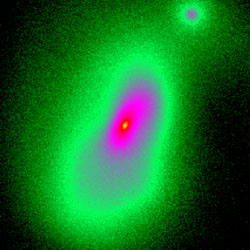 |
Figure 26. Collapse and
fragmentation of a primordial cloud (from
[67]).
Shown is the projected gas density at a redshift z
|
|
The recent discovery of stars like HE0107-5240 with a mass of 0.8
M and an
iron abundance of [Fe/H] = -5.3
[90]
shows that at least some low mass stars could have formed out of extremely
low-metallicity gas. The above simulations show that although the majority
of clumps are very massive, a few of them, like the secondary clump in
Fig. 26, are significantly less
massive. Alternatively, low-mass fragments could form in the dense,
shock-compressed shells that surround the first hypernovae
[234].
and an
iron abundance of [Fe/H] = -5.3
[90]
shows that at least some low mass stars could have formed out of extremely
low-metallicity gas. The above simulations show that although the majority
of clumps are very massive, a few of them, like the secondary clump in
Fig. 26, are significantly less
massive. Alternatively, low-mass fragments could form in the dense,
shock-compressed shells that surround the first hypernovae
[234].
How massive were the first stars? Star formation typically
proceeds from the `inside-out', through the accretion of gas onto a
central hydrostatic core. Whereas the initial mass of the hydrostatic
core is very similar for primordial and present-day star formation
[274],
the accretion process - ultimately responsible for
setting the final stellar mass, is expected to be rather different. On
dimensional grounds, the accretion rate is simply related to the sound
speed cubed over Newton's constant (or equivalently given by the ratio
of the Jeans mass and the free-fall time): Macc ~
cs3 / G
 T3/2. A simple comparison of the temperatures in
present-day star forming regions (T ~ 10 K) with those in
primordial ones (T ~ 200-300 K) already indicates a difference in
the accretion rate of more than two orders of magnitude.
T3/2. A simple comparison of the temperatures in
present-day star forming regions (T ~ 10 K) with those in
primordial ones (T ~ 200-300 K) already indicates a difference in
the accretion rate of more than two orders of magnitude.
The above refined simulation enables one to study the three-dimensional
accretion flow around the protostar (see also
[276,
304,
357]).
The gas may now reach densities of
1012 cm-3 before being incorporated into a central
sink particle. At these high densities, three-body reactions
[280]
convert the gas into a fully molecular form.
Figure 27
shows how the molecular core grows in mass over the first ~
104 yr after its formation. The accretion rate (left
panel) is initially very high, Macc ~ 0.1
M yr-1, and
subsequently declines according to a power law, with a possible break at
~ 5000 yr. The mass of the molecular core (right panel), taken
as an estimator of the proto-stellar mass, grows approximately as:
M* ~
yr-1, and
subsequently declines according to a power law, with a possible break at
~ 5000 yr. The mass of the molecular core (right panel), taken
as an estimator of the proto-stellar mass, grows approximately as:
M* ~

 acc
dt
acc
dt  t0.45. A rough upper limit for the final mass of the
star is then: M*(t = 3 ×
106 yr) ~ 700
M
t0.45. A rough upper limit for the final mass of the
star is then: M*(t = 3 ×
106 yr) ~ 700
M . In
deriving this upper bound, we have conservatively assumed that accretion
cannot go on for longer than the total lifetime of a massive star.
. In
deriving this upper bound, we have conservatively assumed that accretion
cannot go on for longer than the total lifetime of a massive star.
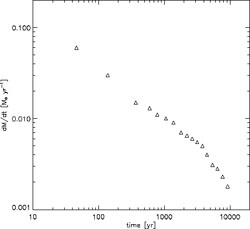 |
 |
Figure 27. Accretion onto a
primordial protostar (from
[67]).
The morphology of this accretion flow is shown in
Fig. 26. Left: Accretion rate (in
M |
|
Can a Population III star ever reach this asymptotic mass limit? The
answer to this question is not yet known with any certainty, and it depends
on whether the accretion from a dust-free envelope is eventually terminated
by feedback from the star (e.g.,
[276,
304,
357,
277]).
The standard mechanism by which accretion may be terminated in
metal-rich gas, namely radiation pressure on dust grains
[386],
is evidently not
effective for gas with a primordial composition. Recently, it has been
speculated that accretion could instead be turned off through the formation
of an H II region
[277],
or through the photo-evaporation of the accretion disk
[357].
The termination of the accretion process
defines the current unsolved frontier in studies of Population III star
formation. Current simulations indicate that the first stars were
predominantly very massive (> 30
M ), and
consequently rather
different from present-day stellar populations. The crucial question then
arises: How and when did the transition take place from the early
formation of massive stars to that of low-mass stars at later times? We
address this problem next.
), and
consequently rather
different from present-day stellar populations. The crucial question then
arises: How and when did the transition take place from the early
formation of massive stars to that of low-mass stars at later times? We
address this problem next.
The very first stars, marking the cosmic Renaissance of structure formation, formed under conditions that were much simpler than the highly complex environment in present-day molecular clouds. Subsequently, however, the situation rapidly became more complicated again due to the feedback from the first stars on the IGM. Supernova explosions dispersed the nucleosynthetic products from the first generation of stars into the surrounding gas (e.g., [241, 261, 361]), including also dust grains produced in the explosion itself [222, 364]. Atomic and molecular cooling became much more efficient after the addition of these metals. Moreover, the presence of ionizing cosmic rays, as well as of UV and X-ray background photons, modified the thermal and chemical behavior of the gas in important ways (e.g., [232, 233]).
Early metal enrichment was likely the dominant effect that brought
about the transition from Population III to Population II star
formation. Recent numerical simulations of collapsing primordial
objects with overall masses of ~ 106
M , have
shown that the gas has to be enriched with heavy elements to a minimum
level of Zcrit
, have
shown that the gas has to be enriched with heavy elements to a minimum
level of Zcrit
 10-3.5
Z
10-3.5
Z , in
order to have any effect on the dynamics and fragmentation properties of
the system
[275,
60,
64].
Normal, low-mass (Population II) stars are
hypothesized to only form out of gas with metallicity Z
, in
order to have any effect on the dynamics and fragmentation properties of
the system
[275,
60,
64].
Normal, low-mass (Population II) stars are
hypothesized to only form out of gas with metallicity Z
 Zcrit. Thus, the characteristic mass scale for star
formation is expected to be a function of metallicity, with a
discontinuity at Zcrit where the mass scale changes by
~ two orders of magnitude. The redshift where this transition occurs has
important implications for the early growth of cosmic structure, and the
resulting observational signature (e.g.,
[392,
141,
234,
322])
include the extended nature of reionization
[144].
Zcrit. Thus, the characteristic mass scale for star
formation is expected to be a function of metallicity, with a
discontinuity at Zcrit where the mass scale changes by
~ two orders of magnitude. The redshift where this transition occurs has
important implications for the early growth of cosmic structure, and the
resulting observational signature (e.g.,
[392,
141,
234,
322])
include the extended nature of reionization
[144].
For additional detailes about the properties of the first stars, see the comprehensive review by Bromm & Larson (2004) [66].
5.3. Gamma-ray Bursts: Probing the First Stars One Star at a Time
Gamma-Ray Bursts (GRBs) are believed to originate in compact remnants (neutron stars or black holes) of massive stars. Their high luminosities make them detectable out to the edge of the visible Universe [94, 214]. GRBs offer the opportunity to detect the most distant (and hence earliest) population of massive stars, the so-called Population III (or Pop III), one star at a time. In the hierarchical assembly process of halos which are dominated by cold dark matter (CDM), the first galaxies should have had lower masses (and lower stellar luminosities) than their low-redshift counterparts. Consequently, the characteristic luminosity of galaxies or quasars is expected to decline with increasing redshift. GRB afterglows, which already produce a peak flux comparable to that of quasars or starburst galaxies at z ~ 1-2, are therefore expected to outshine any competing source at the highest redshifts, when the first dwarf galaxies have formed in the Universe.
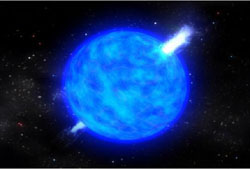 |
Figure 28. Illustration of a long-duration gamma-ray burst in the popular "collapsar" model. The collapse of the core of a massive star (which lost its hydrogen envelope) to a black hole generates two opposite jets moving out at a speed close to the speed of light. The jets drill a hole in the star and shine brightly towards an observer who happened to be located within with the collimation cones of the jets. The jets emenating from a single massive star are so bright that they can be seen across the Universe out to the epoch when the first stars have formed. Upcoming observations by the Swift satellite will have the sensitivity to reveal whether the first stars served as progenitors of gamma-ray bursts (for updates see http://swift.gsfc.nasa.gov/). |
The first-year polarization data from the Wilkinson Microwave
Anisotropy Probe (WMAP) indicates an optical depth to electron
scattering of ~ 17 ± 4% after cosmological recombination
[203,
348].
This implies that the first stars must have formed at
a redshift z ~ 10 - 20, and reionized a substantial fraction of the
intergalactic hydrogen around that time
[83,
93,
345,
394,
403].
Early reionization can be achieved with plausible star formation parameters
in the standard  CDM
cosmology; in fact, the required optical depth
can be achieved in a variety of very different ionization histories since
WMAP places only an integral constraint on these histories
[176].
One would like to probe the full history of reionization in
order to disentangle the properties and formation history of the stars that
are responsible for it. GRB afterglows offer the opportunity to detect
stars as well as to probe the metal enrichment level
[141]
of the intervening IGM.
CDM
cosmology; in fact, the required optical depth
can be achieved in a variety of very different ionization histories since
WMAP places only an integral constraint on these histories
[176].
One would like to probe the full history of reionization in
order to disentangle the properties and formation history of the stars that
are responsible for it. GRB afterglows offer the opportunity to detect
stars as well as to probe the metal enrichment level
[141]
of the intervening IGM.
GRBs, the electromagnetically-brightest explosions in the Universe, should
be detectable out to redshifts z > 10
[94,
214].
High-redshift GRBs can be identified through infrared photometry, based
on the Ly break induced
by absorption of their
spectrum at wavelengths below 1.216 µm [(1 + z) /
10]. Follow-up spectroscopy of high-redshift candidates can then be
performed on a 10-meter-class telescope. Recently, the ongoing
Swift mission
[147]
has detected a GRB originating at z
break induced
by absorption of their
spectrum at wavelengths below 1.216 µm [(1 + z) /
10]. Follow-up spectroscopy of high-redshift candidates can then be
performed on a 10-meter-class telescope. Recently, the ongoing
Swift mission
[147]
has detected a GRB originating at z
 6.3 (e.g.,
[179]),
thus demonstrating the viability of GRBs as probes of the early Universe.
6.3 (e.g.,
[179]),
thus demonstrating the viability of GRBs as probes of the early Universe.
There are four main advantages of GRBs relative to traditional cosmic sources such as quasars:
(i) The GRB afterglow flux at a given observed time lag
after the
 -ray
trigger is not expected to fade significantly with
increasing redshift, since higher redshifts translate to earlier times in
the source frame, during which the afterglow is intrinsically brighter
[94].
For standard afterglow lightcurves and spectra, the
increase in the luminosity distance with redshift is compensated by this
cosmological time-stretching effect.
-ray
trigger is not expected to fade significantly with
increasing redshift, since higher redshifts translate to earlier times in
the source frame, during which the afterglow is intrinsically brighter
[94].
For standard afterglow lightcurves and spectra, the
increase in the luminosity distance with redshift is compensated by this
cosmological time-stretching effect.
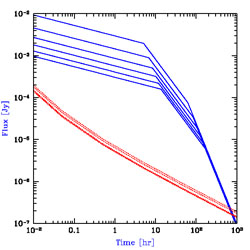 |
Figure 29. GRB afterglow flux as a function
of time since the
|
(ii) As already mentioned, in the standard
 CDM
cosmology, galaxies form hierarchically, starting from small masses and
increasing their average mass with cosmic time. Hence, the characteristic
mass of quasar black holes and the total stellar mass of a galaxy were
smaller at higher redshifts, making these sources intrinsically fainter
[391].
However, GRBs are believed to originate from a stellar mass
progenitor and so the intrinsic luminosity of their engine should not
depend on the mass of their host galaxy. GRB afterglows are therefore
expected to outshine their host galaxies by a factor that gets larger with
increasing redshift.
CDM
cosmology, galaxies form hierarchically, starting from small masses and
increasing their average mass with cosmic time. Hence, the characteristic
mass of quasar black holes and the total stellar mass of a galaxy were
smaller at higher redshifts, making these sources intrinsically fainter
[391].
However, GRBs are believed to originate from a stellar mass
progenitor and so the intrinsic luminosity of their engine should not
depend on the mass of their host galaxy. GRB afterglows are therefore
expected to outshine their host galaxies by a factor that gets larger with
increasing redshift.
(iii) Since the progenitors of GRBs are believed to be
stellar, they likely originate in the most common star-forming galaxies at
a given redshift rather than in the most massive host galaxies, as is the
case for bright quasars
[26].
Low-mass host galaxies
induce only a weak ionization effect on the surrounding IGM and do not
greatly perturb the Hubble flow around them. Hence, the
Ly damping
wing should be closer to the idealized unperturbed IGM case
and its detailed spectral shape should be easier
to interpret. Note also that unlike the case of a quasar, a GRB afterglow
can itself ionize at most ~ 4 × 104 E51
M
damping
wing should be closer to the idealized unperturbed IGM case
and its detailed spectral shape should be easier
to interpret. Note also that unlike the case of a quasar, a GRB afterglow
can itself ionize at most ~ 4 × 104 E51
M of
hydrogen if its UV energy is E51 in units of
1051 ergs (based on the
available number of ionizing photons), and so it should have a negligible
cosmic effect on the surrounding IGM.
of
hydrogen if its UV energy is E51 in units of
1051 ergs (based on the
available number of ionizing photons), and so it should have a negligible
cosmic effect on the surrounding IGM.
(iv) GRB afterglows have smooth (broken power-law) continuum spectra
unlike quasars which show strong spectral features (such as broad emission
lines or the so-called "blue bump") that complicate the extraction of IGM
absorption features. In particular, the continuum extrapolation into the
Ly damping wing (the
so-called Gunn-Peterson absorption trough)
during the epoch of reionization is much more straightforward for the
smooth UV spectra of GRB afterglows than for quasars with an underlying
broad Ly
damping wing (the
so-called Gunn-Peterson absorption trough)
during the epoch of reionization is much more straightforward for the
smooth UV spectra of GRB afterglows than for quasars with an underlying
broad Ly emission line
[26].
emission line
[26].
The optical depth of the uniform IGM to
Ly absorption is
given by (Gunn & Peterson 1965
[163]),
absorption is
given by (Gunn & Peterson 1965
[163]),
 |
(107) |
where H  100h km s-1 Mpc-1
100h km s-1 Mpc-1
 m1/2(1 +
zs)3/2
is the Hubble parameter at the source redshift zs
>> 1,
f
m1/2(1 +
zs)3/2
is the Hubble parameter at the source redshift zs
>> 1,
f =
0.4162 and
=
0.4162 and 
 = 1216 Å are the
oscillator strength and the wavelength of the
Ly
= 1216 Å are the
oscillator strength and the wavelength of the
Ly transition;
nHI(zs) is the neutral
hydrogen density at the source redshift (assuming primordial abundances);
transition;
nHI(zs) is the neutral
hydrogen density at the source redshift (assuming primordial abundances);
 m and
m and
 b are the
present-day density parameters of all matter and of baryons,
respectively; and xHI is the average fraction
of neutral hydrogen. In the second equality we have implicitly considered
high-redshifts, (1 + z) >> max[(1 -
b are the
present-day density parameters of all matter and of baryons,
respectively; and xHI is the average fraction
of neutral hydrogen. In the second equality we have implicitly considered
high-redshifts, (1 + z) >> max[(1 -
 m -
m -

 )
/
)
/  m,
(
m,
(
 /
/
 m)1/3], at which the vacuum energy
density is negligible relative to matter
(
m)1/3], at which the vacuum energy
density is negligible relative to matter
(
 <<
<<  m)
and the Universe is nearly flat; for
m)
and the Universe is nearly flat; for
 m = 0.3,
m = 0.3,

 =
0.7 this corresponds to the condition z >> 1.3 which is
well satisfied by the reionization redshift.
=
0.7 this corresponds to the condition z >> 1.3 which is
well satisfied by the reionization redshift.
At wavelengths longer than
Ly at the source,
the optical depth obtains a small value; these photons redshift away
from the line center along its red wing and never resonate with the line
core on their way to the observer. The red damping wing of the
Gunn-Peterson trough (Miralda-Escudé 1998
[254])
at the source,
the optical depth obtains a small value; these photons redshift away
from the line center along its red wing and never resonate with the line
core on their way to the observer. The red damping wing of the
Gunn-Peterson trough (Miralda-Escudé 1998
[254])
 |
(108) |
where  s is given
in equation (107), also we define
s is given
in equation (107), also we define
 |
(109) |
and
 |
(110) |
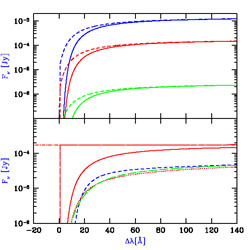 |
Figure 30. Expected spectral shape of the
Ly |
Although the nature of the central engine that powers the relativistic jets
of GRBs is still unknown, recent evidence indicates that long-duration GRBs
trace the formation of massive stars (e.g.,
[365,
383,
45,
211,
47,
264])
and in particular that long-duration GRBs are associated with Type Ib/c
supernovae
[351].
Since the first stars in the Universe are predicted to be predominantly
massive
[5,
62,
66],
their death might give rise to large numbers of
GRBs at high redshifts. In contrast to quasars of comparable brightness,
GRB afterglows are short-lived and release ~ 10 orders of magnitude
less energy into the surrounding IGM. Beyond the scale of their host
galaxy, they have a negligible effect on their cosmological
environment 7.
Consequently, they are ideal probes
of the IGM during the reionization epoch. Their rest-frame UV spectra can
be used to probe the ionization state of the IGM through the spectral shape
of the Gunn-Peterson (Ly )
absorption trough, or its metal
enrichment history through the intersection of enriched bubbles of
supernova (SN) ejecta from early galaxies
[141].
Afterglows that are
unusually bright (> 10 mJy) at radio frequencies should also show a
detectable forest of 21 cm absorption lines due to enhanced HI column
densities in sheets, filaments, and collapsed minihalos within the IGM
[76,
140].
)
absorption trough, or its metal
enrichment history through the intersection of enriched bubbles of
supernova (SN) ejecta from early galaxies
[141].
Afterglows that are
unusually bright (> 10 mJy) at radio frequencies should also show a
detectable forest of 21 cm absorption lines due to enhanced HI column
densities in sheets, filaments, and collapsed minihalos within the IGM
[76,
140].
Another advantage of GRB afterglows is that once they fade away, one may
search for their host galaxies. Hence, GRBs may serve as signposts of the
earliest dwarf galaxies that are otherwise too faint or rare on their own
for a dedicated search to find them. Detection of metal absorption lines
from the host galaxy in the afterglow spectrum, offers an unusual
opportunity to study the physical conditions (temperature, metallicity,
ionization state, and kinematics) in the interstellar medium of these
high-redshift galaxies. As Figure 30 indicates,
damped Ly absorption
within the host galaxy may mask the clear signature
of the Gunn-Peterson trough in some galaxies
[67].
A small fraction ( ~ 10) of the GRB afterglows are expected to originate
at redshifts z > 5
[61,
68].
This subset of afterglows can be
selected photometrically using a small telescope, based on the
Ly
absorption
within the host galaxy may mask the clear signature
of the Gunn-Peterson trough in some galaxies
[67].
A small fraction ( ~ 10) of the GRB afterglows are expected to originate
at redshifts z > 5
[61,
68].
This subset of afterglows can be
selected photometrically using a small telescope, based on the
Ly break at a wavelength of 1.216 µm< [(1 + z) / 10],
caused by
intergalactic HI absorption. The challenge in the upcoming years will be
to follow-up on these candidates spectroscopically, using a large (10-meter
class) telescope. GRB afterglows are likely to revolutionize observational
cosmology and replace traditional sources like quasars, as probes of the
IGM at z > 5. The near future promises to be exciting for GRB
astronomy as well as for studies of the high-redshift Universe.
break at a wavelength of 1.216 µm< [(1 + z) / 10],
caused by
intergalactic HI absorption. The challenge in the upcoming years will be
to follow-up on these candidates spectroscopically, using a large (10-meter
class) telescope. GRB afterglows are likely to revolutionize observational
cosmology and replace traditional sources like quasars, as probes of the
IGM at z > 5. The near future promises to be exciting for GRB
astronomy as well as for studies of the high-redshift Universe.
It is of great importance to constrain the Pop III star formation mode, and in particular to determine down to which redshift it continues to be prominent. The extent of the Pop III star formation will affect models of the initial stages of reionization (e.g., [394, 93, 343, 403, 12]) and metal enrichment (e.g., [234, 141, 144, 320, 340]), and will determine whether planned surveys will be able to effectively probe Pop III stars (e.g., [319]). The constraints on Pop III star formation will also determine whether the first stars could have contributed a significant fraction to the cosmic near-IR background (e.g., [311, 310, 193, 242, 113]). To constrain high-redshift star formation from GRB observations, one has to address two major questions:
(1) What is the signature of GRBs that originate in metal-free, Pop III progenitors? Simply knowing that a given GRB came from a high redshift is not sufficient to reach a definite conclusion as to the nature of the progenitor. Pregalactic metal enrichment was likely inhomogeneous, and we expect normal Pop I and II stars to exist in galaxies that were already metal-enriched at these high redshifts [68]. Pop III and Pop I/II star formation is thus predicted to have occurred concurrently at z > 5. How is the predicted high mass-scale for Pop III stars reflected in the observational signature of the resulting GRBs? Preliminary results from numerical simulations of Pop III star formation indicate that circumburst densities are systematically higher in Pop III environments. GRB afterglows will then be much brighter than for conventional GRBs. In addition, due to the systematically increased progenitor masses, the Pop III distribution may be biased toward long-duration events.
(2) The modelling of Pop III cosmic star formation histories has a number of free parameters, such as the star formation efficiency and the strength of the chemical feedback. The latter refers to the timescale for, and spatial extent of, the distribution of the first heavy elements that were produced inside of Pop III stars, and subsequently dispersed into the IGM by supernova blast waves. Comparing with theoretical GRB redshift distributions one can use the GRB redshift distribution observed by Swift to calibrate the free model parameters. In particular, one can use this strategy to measure the redshift where Pop III star formation terminates.
Figures 31 and 32 illustrate these issues (based on [68]). Figure 32 leads to the robust expectation that ~ 10% of all Swift bursts should originate at z > 5. This prediction is based on the contribution from Population I/II stars which are known to exist even at these high redshifts. Additional GRBs could be triggered by Pop III stars, with a highly uncertain efficiency. Assuming that long-duration GRBs are produced by the collapsar mechanism, a Pop III star with a close binary companion provides a plausible GRB progenitor. The Pop III GRB efficiency, reflecting the probability of forming sufficiently close and massive binary systems, to lie between zero (if tight Pop III binaries do not exist) and ~ 10 times the empirically inferred value for Population I/II (due to the increased fraction of black hole forming progenitors among the massive Pop III stars).
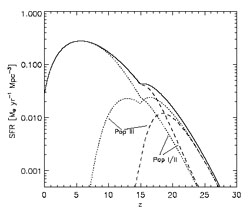 |
Figure 31. Theoretical prediction for the
comoving star formation rate (SFR) in units of
M |
A key ingredient in determining the underlying star formation history from the observed GRB redshift distribution is the GRB luminosity function, which is only poorly constrained at present. The improved statistics provided by Swift will enable the construction of an empirical luminosity function. With an improved luminosity function it would be possible to re-calibrate the theoretical prediction in Figure 32 more reliably.
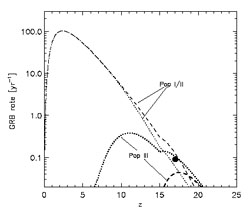 |
Figure 32. Predicted GRB rate to be
observed by Swift (from
[68]).
Shown is the observed number of bursts per year,
dNGRBobs / dln(1 + z), as a
function of redshift. All rates are calculated with a constant GRB
efficiency,
|
In order to predict the observational signature of high-redshift GRBs, it
is important to know the properties of the GRB host systems. Within
variants of the popular CDM model for structure formation, where small
objects form first and subsequently merge to build up more massive ones,
the first stars are predicted to form at z ~ 20 - 30 in minihalos of
total mass (dark matter plus gas) ~ 106
M [359,
23,
403].
These objects are the sites for the formation
of the first stars, and thus are the potential hosts of the
highest-redshift GRBs. What is the environment in which the earliest
GRBs and their afterglows did occur? This problem breaks down into two
related questions: (i) what type of stars (in terms of mass, metallicity,
and clustering properties) will form in each minihalo?, and (ii) how will
the ionizing radiation from each star modify the density structure of the
surrounding gas? These two questions are fundamentally intertwined. The
ionizing photon production strongly depends on the stellar mass, which in
turn is determined by how the accretion flow onto the growing protostar
proceeds under the influence of this radiation field. In other words, the
assembly of the Population III stars and the development of an HII region
around them proceed simultaneously, and affect each other. As a
preliminary illustration, Figure 27 describes
the photo-evaporation as a self-similar champagne flow
[337]
with parameters appropriate for the Pop III case.
[359,
23,
403].
These objects are the sites for the formation
of the first stars, and thus are the potential hosts of the
highest-redshift GRBs. What is the environment in which the earliest
GRBs and their afterglows did occur? This problem breaks down into two
related questions: (i) what type of stars (in terms of mass, metallicity,
and clustering properties) will form in each minihalo?, and (ii) how will
the ionizing radiation from each star modify the density structure of the
surrounding gas? These two questions are fundamentally intertwined. The
ionizing photon production strongly depends on the stellar mass, which in
turn is determined by how the accretion flow onto the growing protostar
proceeds under the influence of this radiation field. In other words, the
assembly of the Population III stars and the development of an HII region
around them proceed simultaneously, and affect each other. As a
preliminary illustration, Figure 27 describes
the photo-evaporation as a self-similar champagne flow
[337]
with parameters appropriate for the Pop III case.
 |
Figure 33. Effect of photoheating from a Population III star on the density profile in a high-redshift minihalo (from [69]). The curves, labeled by the time after the onset of the central point source, are calculated according to a self-similar model for the expansion of an HII region. Numerical simulations closely conform to this analytical behavior. Notice that the central density is significantly reduced by the end of the life of a massive star, and that a central core has developed where the density is constant. |
Notice that the central density is significantly reduced by the end of the
life of a massive star, and that a central core has developed where the
density is nearly constant. Such a flat density profile is markedly
different from that created by stellar winds
(
 r-2). Winds, and consequently mass-loss, may not be
important for massive Population III stars
[18,
210],
and such a flat density profile may be
characteristic of GRBs that originate from metal-free Population III
progenitors.
r-2). Winds, and consequently mass-loss, may not be
important for massive Population III stars
[18,
210],
and such a flat density profile may be
characteristic of GRBs that originate from metal-free Population III
progenitors.
The first galaxies may be surrounded by a shell of highly enriched material that was carried out in a SN-driven wind (see Fig. 34). A GRB in that galaxy may show strong absorption lines at a velocity separation associated with the wind velocity. Simulating these winds and calculating the absorption profile in the featureless spectrum of a GRB afterglow, will allow us to use the observed spectra of high-z GRBs and directly probe the degree of metal enrichment in the vicinity of the first star forming regions (see [141] for a semi-analytic treatment).
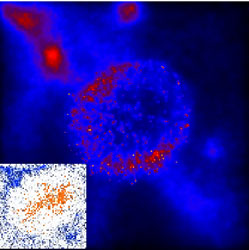 |
Figure 34. Supernova explosion in the
high-redshift Universe (from
[65]).
The snapshot is taken ~ 106 yr after the explosion with
total energy ESN
|
As the early afterglow radiation propagates through the interstellar environment of the GRB, it will likely modify the gas properties close to the source; these changes could in turn be noticed as time-dependent spectral features in the spectrum of the afterglow and used to derive the properties of the gas cloud (density, metal abundance, and size). The UV afterglow radiation can induce detectable changes to the interstellar absorption features of the host galaxy [289]; dust destruction could have occurred due to the GRB X-rays [375, 136], and molecules could have been destroyed near the GRB source [112]. Quantitatively, all of the effects mentioned above strongly depend on the exact properties of the gas in the host system.
Most studies to date have assumed a constant efficiency of forming GRBs per unit mass of stars. This simplifying assumption could lead, under different circumstances, to an overestimation or an underestimation of the frequency of GRBs. Metal-free stars are thought to be massive [5, 62] and their extended envelopes may suppress the emergence of relativistic jets out of their surface (even if such jets are produced through the collapse of their core to a spinning black hole). On the other hand, low-metallicity stars are expected to have weak winds with little angular momentum loss during their evolution, and so they may preferentially yield rotating central configurations that make GRB jets after core collapse.
What kind of metal-free, Pop III progenitor stars may lead to GRBs? Long-duration GRBs appear to be associated with Type Ib/c supernovae [351], namely progenitor massive stars that have lost their hydrogen envelope. This requirement is explained theoretically in the collapsar model, in which the relativistic jets produced by core collapse to a black hole are unable to emerge relativistically out of the stellar surface if the hydrogen envelope is retained [231]. The question then arises as to whether the lack of metal line-opacity that is essential for radiation-driven winds in metal-rich stars, would make a Pop III star retain its hydrogen envelope, thus quenching any relativistic jets and GRBs.
Aside from mass transfer in a binary system, individual PopIII stars could
lose their hydrogen envelope due to either: (i) violent pulsations,
particularly in the mass range 100 - 140
M , or
(ii) a wind
driven by helium lines. The outer stellar layers are in a state where
gravity only marginally exceeds radiation pressure due to
electron-scattering (Thomson) opacity. Adding the small, but still
non-negligible contribution from the bound-free opacity provided by
singly-ionized helium, may be able to unbind the atmospheric
gas. Therefore, mass-loss might occur even in the absence of dust or any
heavy elements.
, or
(ii) a wind
driven by helium lines. The outer stellar layers are in a state where
gravity only marginally exceeds radiation pressure due to
electron-scattering (Thomson) opacity. Adding the small, but still
non-negligible contribution from the bound-free opacity provided by
singly-ionized helium, may be able to unbind the atmospheric
gas. Therefore, mass-loss might occur even in the absence of dust or any
heavy elements.
5.4. Emission Spectrum of Metal-Free Stars
The evolution of metal-free (Population III) stars is qualitatively
different from that of enriched (Population I and II) stars. In the
absence of the catalysts necessary for the operation of the CNO cycle,
nuclear burning does not proceed in the standard way. At first,
hydrogen burning can only occur via the inefficient PP chain. To
provide the necessary luminosity, the star has to reach very high
central temperatures (Tc
 108.1
K). These temperatures
are high enough for the spontaneous turn-on of helium burning via the
triple-
108.1
K). These temperatures
are high enough for the spontaneous turn-on of helium burning via the
triple- process. After a
brief initial period of
triple-
process. After a
brief initial period of
triple- burning, a trace
amount of heavy elements
forms. Subsequently, the star follows the CNO cycle. In constructing
main-sequence models, it is customary to assume that a trace mass
fraction of metals (Z ~ 10-9) is already present in
the star (El Eid 1983
[115];
Castellani et al. 1983
[78]).
burning, a trace
amount of heavy elements
forms. Subsequently, the star follows the CNO cycle. In constructing
main-sequence models, it is customary to assume that a trace mass
fraction of metals (Z ~ 10-9) is already present in
the star (El Eid 1983
[115];
Castellani et al. 1983
[78]).
Figures 35 and 36 show
the luminosity L vs.
effective temperature T for zero-age main sequence stars in the mass
ranges of 2 - 90
M (Fig. 35) and 100 - 1000
M
(Fig. 35) and 100 - 1000
M (Fig. 36). Note that above ~
100M
(Fig. 36). Note that above ~
100M the
effective temperature is roughly constant, Teff ~
105 K,
implying that the spectrum is independent of the mass distribution of
the stars in this regime (Bromm, Kudritzky, & Loeb 2001
[59]).
As is evident from these figures (see also Tumlinson & Shull 2000
[370]),
both the effective temperature and the ionizing power of metal-free (Pop
III) stars are substantially larger than those of metal-rich (Pop I)
stars. Metal-free stars with masses >
20M
the
effective temperature is roughly constant, Teff ~
105 K,
implying that the spectrum is independent of the mass distribution of
the stars in this regime (Bromm, Kudritzky, & Loeb 2001
[59]).
As is evident from these figures (see also Tumlinson & Shull 2000
[370]),
both the effective temperature and the ionizing power of metal-free (Pop
III) stars are substantially larger than those of metal-rich (Pop I)
stars. Metal-free stars with masses >
20M emit
between
1047 and 1048 H I and He I ionizing photons
per second per solar mass of stars, where the lower value applies to
stars of ~ 20
M
emit
between
1047 and 1048 H I and He I ionizing photons
per second per solar mass of stars, where the lower value applies to
stars of ~ 20
M and
the upper value applies to stars of >
100 M
and
the upper value applies to stars of >
100 M (see Tumlinson & Shull 2000
[370]
and Bromm et al. 2001
[59]
for more details). Over a lifetime of ~ 3 × 106 years these
massive stars produce 104 - 105 ionizing photons
per stellar
baryon. However, this powerful UV emission is suppressed as soon as
the interstellar medium out of which new stars form is enriched by
trace amounts of metals. Even though the collapsed fraction of baryons
is small at the epoch of reionization, it is likely that most of the
stars responsible for the reionization of the Universe formed out of
enriched gas.
(see Tumlinson & Shull 2000
[370]
and Bromm et al. 2001
[59]
for more details). Over a lifetime of ~ 3 × 106 years these
massive stars produce 104 - 105 ionizing photons
per stellar
baryon. However, this powerful UV emission is suppressed as soon as
the interstellar medium out of which new stars form is enriched by
trace amounts of metals. Even though the collapsed fraction of baryons
is small at the epoch of reionization, it is likely that most of the
stars responsible for the reionization of the Universe formed out of
enriched gas.
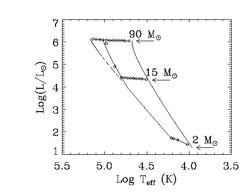 |
Figure 35. Luminosity vs. effective
temperature for zero-age main sequences stars in the mass range of 2 -
90M |
 |
Figure 36. Same as
Figure 35 but for very massive stars above
100M |
Will it be possible to infer the initial mass function (IMF) of
the first stars from spectroscopic observations of the first
galaxies? Figure 37 compares the observed
spectrum from a
Salpeter IMF (dN* /
dM  M-2.35) and a heavy IMF (with
all stars more massive than 100
M
M-2.35) and a heavy IMF (with
all stars more massive than 100
M ) for a
galaxy at zs = 10. The latter case follows from the
assumption that each of the
dense clumps in the simulations described in the previous section ends
up as a single star with no significant fragmentation or mass
loss. The difference between the plotted spectra cannot be confused
with simple reddening due to normal dust. Another distinguishing
feature of the IMF is the expected flux in the hydrogen and helium
recombination lines, such as
Ly
) for a
galaxy at zs = 10. The latter case follows from the
assumption that each of the
dense clumps in the simulations described in the previous section ends
up as a single star with no significant fragmentation or mass
loss. The difference between the plotted spectra cannot be confused
with simple reddening due to normal dust. Another distinguishing
feature of the IMF is the expected flux in the hydrogen and helium
recombination lines, such as
Ly and He II 1640
Å, from the interstellar medium surrounding these stars. We discuss
this next.
and He II 1640
Å, from the interstellar medium surrounding these stars. We discuss
this next.
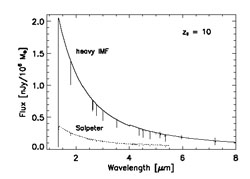 |
Figure 37. Comparison of the predicted flux
from a Pop III star cluster
at zs = 10 for a Salpeter IMF (Tumlinson & Shull
2000
[370])
and a massive IMF (Bromm et al. 2001
[59]).
Plotted is the observed flux (in nJy per 106
M |
5.5. Emission of Recombination Lines from the First Galaxies
The hard UV emission from a star cluster or a quasar at high redshift
is likely reprocessed by the surrounding interstellar medium,
producing very strong recombination lines of hydrogen and helium (Oh 1999
[270];
Tumlinson & Shull 2000
[370];
see also Baltz, Gnedin & Silk 1998
[17]).
We define  ion
to be the production rate of
ionizing photons by the source. The emitted luminosity
Llineem per unit stellar mass in a
particular recombination line is then estimated to be
ion
to be the production rate of
ionizing photons by the source. The emitted luminosity
Llineem per unit stellar mass in a
particular recombination line is then estimated to be
 |
(111) |
where plineem is the probability that a
recombination leads
to the emission of a photon in the corresponding line,
 is the
frequency of the line and pcontesc and
plineesc are the escape probabilities for
the ionizing photons and the line
photons, respectively. It is natural to assume that the stellar cluster is
surrounded by a finite H II region, and hence that
pcontesc is close to zero
[387,
302].
In addition, plineesc
is likely close to unity in the H II region, due to the lack of dust in the
ambient metal-free gas. Although the emitted line photons may be scattered
by neutral gas, they diffuse out to the observer and in the end survive if
the gas is dust free. Thus, for simplicity, we adopt a value of unity for
plineesc.
is the
frequency of the line and pcontesc and
plineesc are the escape probabilities for
the ionizing photons and the line
photons, respectively. It is natural to assume that the stellar cluster is
surrounded by a finite H II region, and hence that
pcontesc is close to zero
[387,
302].
In addition, plineesc
is likely close to unity in the H II region, due to the lack of dust in the
ambient metal-free gas. Although the emitted line photons may be scattered
by neutral gas, they diffuse out to the observer and in the end survive if
the gas is dust free. Thus, for simplicity, we adopt a value of unity for
plineesc.
As a particular example we consider case B recombination which yields
plineem of about 0.65 and 0.47 for the
Ly and He
II 1640 Å lines, respectively. These numbers correspond to an electron
temperature of ~ 3 × 104K and an electron density of ~
102 - 103 cm-3 inside the H II region
[354].
For example, we consider the extreme and most favorable case of
metal-free stars all of which are more massive than ~ 100
M
and He
II 1640 Å lines, respectively. These numbers correspond to an electron
temperature of ~ 3 × 104K and an electron density of ~
102 - 103 cm-3 inside the H II region
[354].
For example, we consider the extreme and most favorable case of
metal-free stars all of which are more massive than ~ 100
M . In
this case Llineem = 1.7 ×
1037 and 2.2 × 1036 erg s-1
M
. In
this case Llineem = 1.7 ×
1037 and 2.2 × 1036 erg s-1
M -1 for the recombination luminosities of
Ly
-1 for the recombination luminosities of
Ly and
He II 1640 Åper stellar mass
[59].
A cluster of 106
M
and
He II 1640 Åper stellar mass
[59].
A cluster of 106
M in
such stars would then produce 4.4 and 0.6 × 109
L
in
such stars would then produce 4.4 and 0.6 × 109
L in the
Ly
in the
Ly and He II
1640 Å lines. Comparably-high luminosities would be produced in other
recombination lines at longer wavelengths, such as He II 4686 Å and
H
and He II
1640 Å lines. Comparably-high luminosities would be produced in other
recombination lines at longer wavelengths, such as He II 4686 Å and
H [270,
271].
[270,
271].
The rest - frame equivalent width of the above emission lines measured against the stellar continuum of the embedded star cluster at the line wavelengths is given by
 |
(112) |
where L is the spectral luminosity per unit wavelength of
the stars at the line resonance. The extreme case of metal-free stars
which are more massive than 100
M
is the spectral luminosity per unit wavelength of
the stars at the line resonance. The extreme case of metal-free stars
which are more massive than 100
M yields
a spectral luminosity per unit frequency
L
yields
a spectral luminosity per unit frequency
L = 2.7 × 1021 and 1.8 ×
1021 erg s-1 Hz-1
M
= 2.7 × 1021 and 1.8 ×
1021 erg s-1 Hz-1
M -1 at the corresponding wavelengths
[59].
Converting to L
-1 at the corresponding wavelengths
[59].
Converting to L , this yields rest-frame equivalent widths of
W
, this yields rest-frame equivalent widths of
W = 3100 Å and
1100 Å for Ly
= 3100 Å and
1100 Å for Ly and
He II 1640 Å,
respectively. These extreme emission equivalent widths are more than
an order of magnitude larger than the expectation for a normal cluster
of hot metal-free stars with the same total mass and a Salpeter IMF
under the same assumptions concerning the escape probabilities and
recombination
[209].
The equivalent widths are, of course, larger by a factor of (1 +
zs) in the observer frame.
Extremely strong recombination lines, such as
Ly
and
He II 1640 Å,
respectively. These extreme emission equivalent widths are more than
an order of magnitude larger than the expectation for a normal cluster
of hot metal-free stars with the same total mass and a Salpeter IMF
under the same assumptions concerning the escape probabilities and
recombination
[209].
The equivalent widths are, of course, larger by a factor of (1 +
zs) in the observer frame.
Extremely strong recombination lines, such as
Ly and
He II 1640 Å, are therefore expected to be an additional
spectral signature that is unique to very massive stars in the early
Universe. The strong recombination lines from the first luminous
objects are potentially detectable with JWST
[271].
and
He II 1640 Å, are therefore expected to be an additional
spectral signature that is unique to very massive stars in the early
Universe. The strong recombination lines from the first luminous
objects are potentially detectable with JWST
[271].
6 See http://www.ukaff.ac.uk/starcluster for an animation. Back.
7 Note, however, that feedback from a single GRB or supernova on the gas confined within early dwarf galaxies could be dramatic, since the binding energy of most galaxies at z > 10 is lower than 1051 ergs [23]. Back.